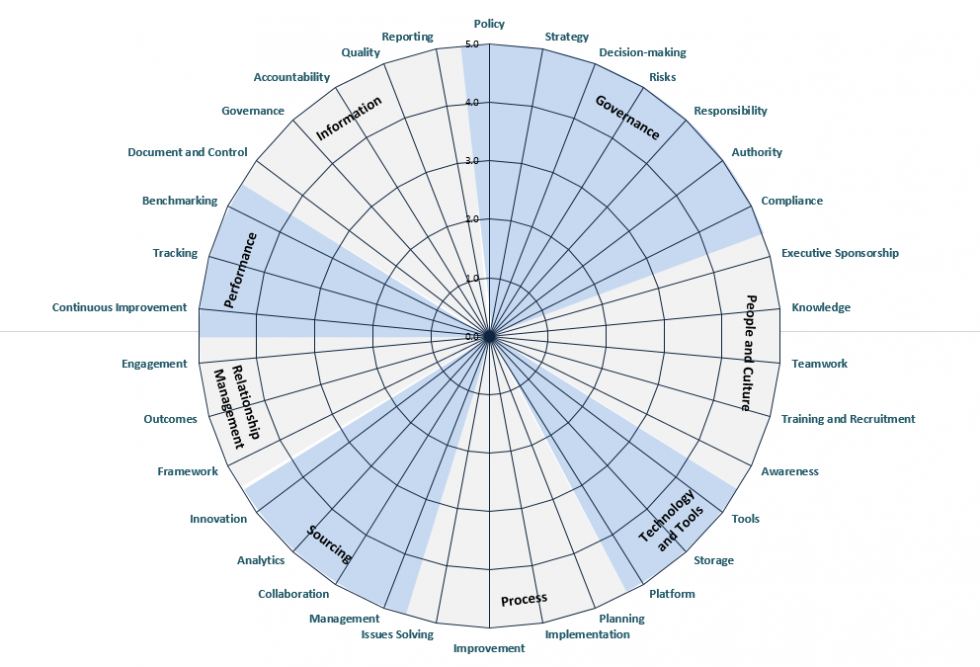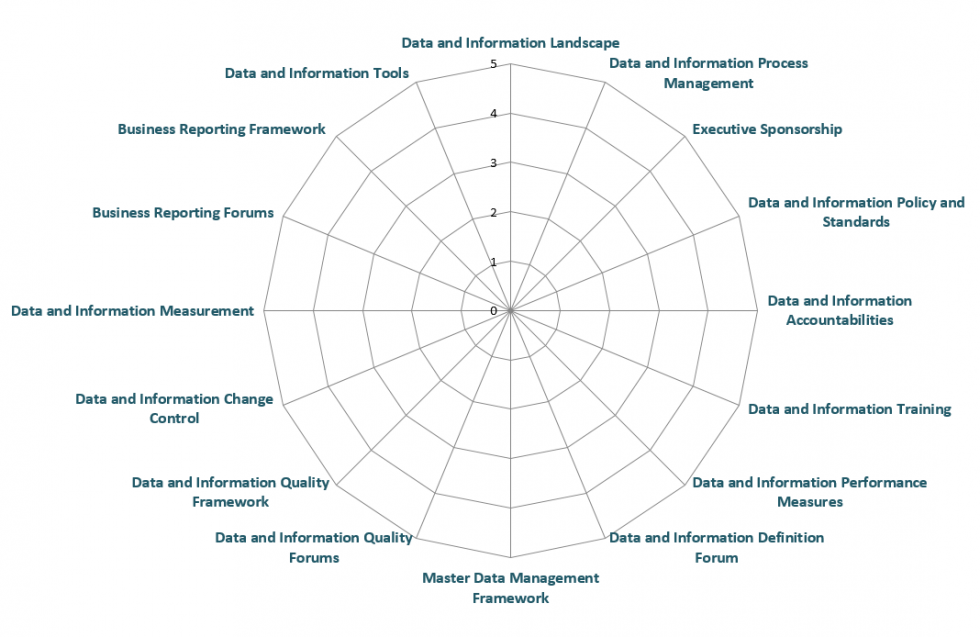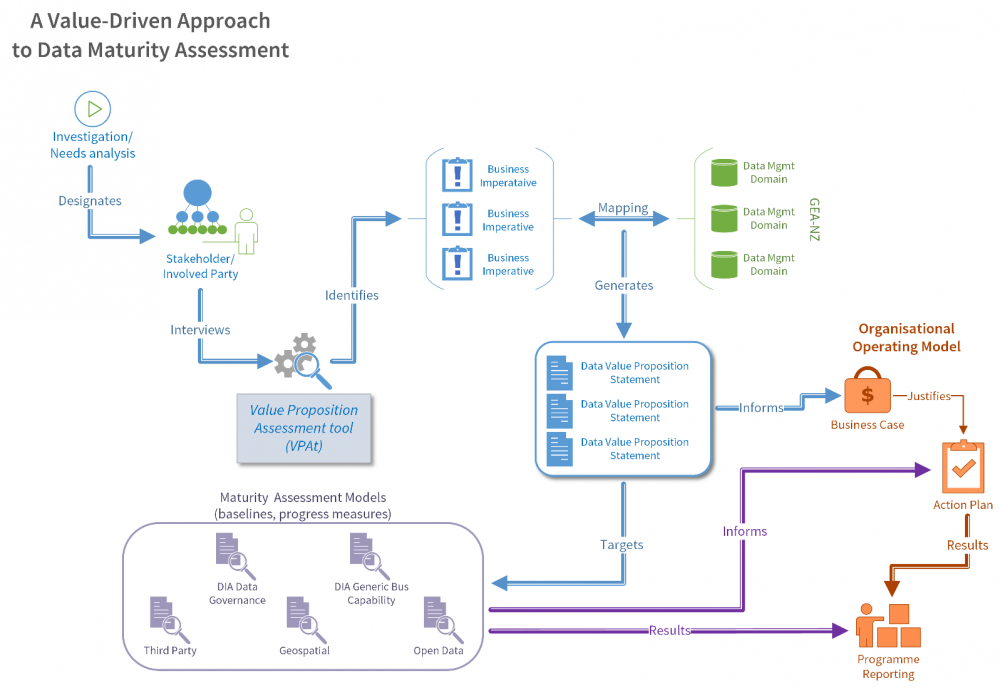This paper proposes a simple approach/tool (VPAt) for identifying the value propositions of explicit data management domains for stakeholder business imperatives.
Data management frameworks are traditionally unrelatable to anyone other than highly capable data practitioners who themselves often struggle to articulate the business implications of good data management practices.
By qualifying up front the business imperatives for which data management practices are relevant, and understanding the perspectives of stakeholders that care most about each of the business imperatives, it is possible to present the stakeholders with a compelling and enticing data management story.
The value proposition assessment derives from two overlapping sets of information:
Once these two sets of information have been coarsely determined the refinement of value propositions takes place by iterating through both sets in increasing detail. Two or three iterations is usually sufficient to present well-defined value propositions to specific stakeholders.
Each information set can be represented as a table:
| Business imperatives | |
| Stakeholder classes | Mappings |
And
| Business imperatives | |
| Data management domains | Mappings |
Analysis needs to be conducted at xx points:
Iteration involves increasing the granularity of the business imperatives and perhaps the granularity of the data management domains.
Identify the stakeholder or involved party based on their relation to business imperatives:
| Business imperatives | ||||||
| Performance | Risk | Cost | Innovation | Open by Design | ||
| Stakeholders and Involved Partners |
Public | Primary | Primary | Primary | ||
| Ministers | Primary | Primary | Primary | Primary | Primary | |
| Govt System Leads | Primary | Primary | Primary | Primary | Primary | |
| CEs | Primary | Primary | Primary | Primary | Primary | |
| DCEs | Primary | Primary | Primary | Primary | Primary | |
| GMs | Primary | Primary | Primary | |||
| Practitioners | Primary | Primary | ||||
| Data Analysts | Primary | Primary | Secondary | |||
| Data Administrators | Primary | Primary | ||||
| Proj/Prog Managers | Primary | Primary | Primary | |||
| Developers | Primary | Secondary | Secondary | |||
| Classifiers | Primary | |||||
| Architects | Primary | Primary | Secondary | Secondary | ||
| Business Analysts | Primary | Secondary | ||||
| Partners | Primary | Primary | ||||
| Suppliers | Primary | Primary | Primary | |||
| Regulators | Primary | |||||
There are several ways to factor data management as a whole. This assessment employs the Government Enterprise Architecture for NZ (GEA-NZ) Reference Framework as the guiding context.
Government Enterprise Architecture for NZ Reference Framework – Digital.govt.nz
GEA-NZ includes eight dimensions which are organised here under five data-centric domains:
These data domains are tabulated against business imperatives to identify value propositions. Each of the mappings needs articulation as a data domain value statement (This data domain provides value “By…”) and this is best completed by a business-oriented data practitioner.
| Business imperatives | ||||||
| increases Performance (Deliverables) |
reduces Risk |
reduces Cost |
increases Innovation |
supports Open by Design |
||
| Data Domains |
Strategy
|
By requiring a clear investment roadmap that delivers the right data-dependent capabilities at the time the business requires them | By requiring the identification and documentation of data, related processes and systems so that risks can be explicitly managed | By requiring a comprehensive view and understanding of data-related investment and expenditures | By requiring environments and platforms for data to contribute to the development of new opportunities | By requiring architecture and governance suitable to establish an open data mindset, practice and culture |
|
Architecture
|
By defining the changes in data, data-related process and systems to deliver business objectives | By defining data, data-related process and systems to reduce complexity | By defining data, data-related process and systems to increase certainty of investment and expenditures | By defining environments and platforms for data to contribute to the development of new opportunities | By defining environments and platforms to contribute to an open data mindset, practice and culture | |
|
Governance
|
By providing consistent authorisation, definition and description of data, related processes and systems | By providing clear accountabilities for data, related processes and systems | By providing a mechanism for controlling data-related investment and expenditures | By providing the environments and platforms for data to contribute to the development of new opportunities | By providing the environments and platforms to contribute to an open data mindset, practice and culture | |
|
Operations
|
By operating the business effectively | By responsibly executing business activities | By operating the business efficiently | By improving efficiencies, so that resources can be released to increase opportunity | By providing the context for maximising the use of data throughout its lifecycle | |
|
Quality
|
By providing fit for purpose, accurate and trusted data for evidence-based decisions | By minimising risk to the reputation of the organisation | By minimising data maintenance costs | By enabling the organisation to maximise value and opportunity of data assets | By instilling a high level of confidence in data available for re-use | |
It is now possible to make statements like:
“Ministers, Agency leadership, operational staff, and partners care about data quality because it reduces risk by ….”
The set of value proposition statements resulting from the application of the VPAt to relevant business imperatives can be used to inform the selection of a relevant maturity assessment and then to target specific areas of measurement within that assessment. The VPAt increases the likelihood that the measures identified for maturity analysis are congruent with and can be linked directly to particular organisational business objectives.
Because the data domains used in the VPAt draw from the same architectural reference model (GEA-NZ) as the DIA Generic Business Capability and DIA Data and Information Governance maturity models (Figure 1), there is an especially strong alignment between the value proposition statements and the set of DIA measures designed to characterise organisational data maturity.
This provides a level of analytical consistency that expedites a clear line of sight throughout the data maturity assessment process and facilitates meaningful outcomes.

Figure 1. DIA Generic Business Capability Model

Figure 2. DIA Data and Information Governance Maturity Model
However, if other data maturity assessments – for instance those offered by third parties or those for open data or geospatial data published by New Zealand government - are deemed valuable, the VPAt outputs can also be used to develop an approach for growing organisational data maturity in those areas.
In this way, the VPAt can serve as a lens to focus organisational efforts on developing those data management capabilities that provide the highest level of support for business imperatives. Meaningful baselines can be established and a potential maturity path designed to not only support business objectives generally, but furthermore to provide a powerful means of demonstrating the critical business value of good data management practice.
The VPAt value proposition statements, in conjunction with data maturity assessment results, are available to inform organisational operating models and facilitate successful data outcomes (Figure 3).
Value statements can be employed directly in the development of data-related business cases, strengthening the proposition for investment in organisational data assets and capabilities.
In addition, they can help target the selection and optimal use of data maturity assessments, ensuring that assessment activities are meaningful, manageable and maintain a clear line of sight to business imperatives.
In this way the outcomes of a data maturity assessment, including baselines and sets of progress measures, are more likely to provide real business value. With an intentional alignment to organisational business imperatives, assessment outcomes are well positioned to inform the development and implementation of data-related action plans and provide a structure for reporting.

Figure 3. The VPAt supports organisational operating models, informing business case development and targeting the selection of maturity assessments which can be used to inform action plan design and reporting.
If you’d like more information, have a question, or want to provide feedback, email datalead@stats.govt.nz.
Content last reviewed 16 July 2021.